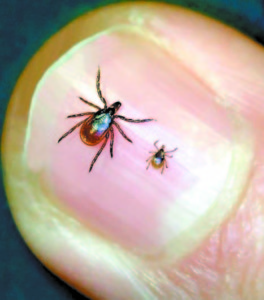CDC does tick check with county residents
Staff Writer
FALMOUTH — Like any successful predator, the tick lies in wait — hiding in the wood pile, lurking under that pile of leaves, crawling across the unmowed lawn toward the warmth of human blood in the home.
The dreaded deer tick is active any time the temperature is above freezing so any early thaw or late freeze gives the tick the advantage. Homeowners sometimes provide the perfect, damp hiding spots for deer ticks. Or sometimes, they catch a ride into the home in the fur of pets. Not to mention, the deer tick’s miniscule size means it might get overlooked.
“Deer ticks are most common in the spring and fall months,†according to Molly Pinho, with the Maine Center of Disease Control & Prevention (CDC). “In the early phase of a deer tick’s life cycle, the tick can be as small as a poppy seed.â€
There are 14 species of ticks in Maine.
However, two types — the dog tick and the deer tick are most common.
“In Maine, the dog ticks don’t carry diseases,†Pinho said.
“The deer ticks carry three types of diseases that can be transmitted to humans: Lyme disease, anaplasmosis and babesiosis,†she said.
On Monday, June 5, Pinho joined coworker Lindsay McFarren to give a presentation on tick- and mosquito-borne illnesses and how to prevent them. The lecture was offered through the Cumberland County Cooperative Extension and held at the University of Maine’s Regional Learning Center in Falmouth.
Approximately 100 people attended the free lecture. Some of the people had firsthand experiences of getting Lyme disease, but it had not altered their outdoor activities. Many people attested that their dog had contracted Lyme from a tick. The audience included outdoors enthusiasts, dog owners, people on conservation committees in their respective towns and people in the medical field.
Sitting in the seats was a crew from Lawn Dawg, a lawn-care and insect-control business. Those employees ended up having firsthand knowledge of ticks.
Someone in the audience asked how long a tick could live inside a house while not feeding on a host.
The Lawn Dawg employees spoke up. One said he had a tick in a jar and it lived for one month. The other guy said the male deer tick can live up to 1000 days without a meal.
For those Mainers who do their own yardwork, there are ways to make one’s property less appealing to ticks.
The CDC presentation included ways to reduce the tick habitat around your home. Those include seasonal chores like raking the lawn to remove dead leaves and keeping the lawn mowed at a height of three inches or less.
People should keep their wood piles and rock walls neat, which prevents those places becoming the homes for chipmunks and squirrels that ticks might attach to.
Another piece of advice is to create a three-foot barrier of mulch or wood chips around the home — where the forest meets the lawn.
“Ticks like to hang out in area that are nice and moist,†McFarren said.
“Most tick encounters are where your lawn meets the woods. The mulch barrier will cause the tick to dry out before it gets to your home,†she said.
She recommended wood chip mulch.
“Wood piles are a really great place where ticks like to hang out, keep those as far from the home as possible,†she said.
Someone in the audience asked about Japanese Barberries, an invasive species that attracts deer. The CDC recommends keeping deer habitat at a minimum in the yard.
“Ticks are unable to survive in open areas that are exposed to wind and sun that dries them out,†McFarren said.
Other important tips include: wear repellent, check for ticks daily, shower soon after being outdoors, put outdoor clothing in dryer on high and use rubbing alcohol to kill ticks. The CDC representatives also advised people to visit their doctor if they show symptoms of a tick-bourne illness such as a rash or fever after being bit by a tick.
It takes 24 hours of being attached to its host for the deer tick to transmit Lyme disease. Therefore, catching and removing ticks is paramount to staying free of the diseases they carry.


